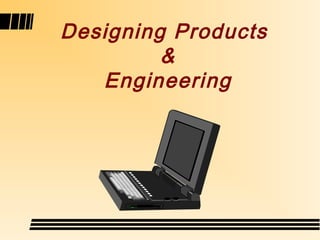
Qcd pencil
- 1. Designing Products & Engineering
- 2. Customers’ Requirements Normal Requirements are typically what we get by just asking customers what they want. Expected Requirements are often so basic the customer may fail to mention them - until we fail to perform them. For example, if coffee is served hot, customers barely notice it. If it's cold or too hot, dissatisfaction occurs. Expected requirements must be fulfilled. Exciting Requirements are difficult to discover. They are beyond the customer's expectations. For example, if full meals were served on a flight from Chicago to Indianapolis, that would be exciting. If not, customers would hardly complain.
- 3. Kano Model [Noriaki Kano 1984].
- 4. The Overall Goal Increase customer satisfaction = Increase business success
- 5. QUALITY FUNCTION DEPLOYMENT Quality Function Deployment Voice of the customer House of quality QFD: An approach that integrates the “voice of the customer” into the product and service development process.
- 6. House Of Quality Correlation Matrix Product Characteristics HOW Customer Relationship Marketing Requirements matrix Competitive WHAT assessment How Much Engineering Competitive Assessment
- 7. The “What” room implies the voice of the customer, located at the left portion of the matrix. It answers the question, “What requirements should be satisfied, or are there any special features which the customer would be delighted to discover?”
- 8. The “How” room Voice of the Engineers or Designers (“hows”). Each "whats" item must be converted (refined) to “how(s)” They have to be actionable (quantifiable or measurable) located under the “Correlation Matrix” roof. It answers the question, “How can these customer requirements be met in terms of design requirements?”
- 9. the “Relationship Matrix.” It is the linkage between the engineering design requirements and voice of the customer. Correlates how “hows” satisfy “whats” Use symbolic notation for depicting weak, medium, and strong relationships Generally, – A circle within a circle indicates a strong correlation between the two. – A single circle shows a moderate correlation – A triangle represents a weak correlation.
- 10. The “How Much” room “How much’s" of the “Hows“ (measurement) Answers a common design question: "How much is good enough (to satisfy the customer)?“ located in the box beneath the relationship matrix. Clearly stated in a measurable way as to how customer requirements are met Provides designers with specific technical guidance
- 11. The “Correlation Matrix” roof Identifies how “hows” items support (positive) or conflict (negative) with one another Find trade-offs for negative items by adjusting “how much” values. Trade-offs must be resolved or customer requirements won’t be fully satisfied. There are two consequences of a negative correlation. – The first consequence is to redesign the product in order to eliminate the tradeoffs. – The second consequence is to determine an optimization target in which the design tradeoffs are included with their relative importance to the customer considered.
- 12. The “Engineering Competitive Assessment” room collects the data in engineering terms and records it on the chart. Each item is scaled separately as it relates to its relative merit for each test from good to poor. The “Engineering Competitive Assessment” room is recorded below the “How Much” room and corresponds to the “How” room column. An importance rating is assigned to each test on a certain scale.
- 13. The “Marketing Competitive Assessment” room Also called the “Customer Competitive Assessment” room. Its location is next to the “Relationship Matrix” room. This competitive benchmarking helps identify the current best-in-class designs as well as the strengths and weaknesses of each design. A weighted scale is also applied to the system.
- 14. An Example with Completed QFD Matrices: Product Planning Matrix for Pencil
- 15. BEFORE AND AFTER QFD BEFORE PLANNING DESIGN REDESIGN MANUFACTURING QFD AFTER PLANNING DESIGN REDESIGN MANUFACTURING QFD BENEFITS Development time KEY DIFFERENCES $$ Before QFD After QFD Customer satisfaction sequential development simultaneous development across functions function involvement by phase all functions participate from start management approval by phase team empowered to make decisions tasks assigned by function tasks shared across functions functionally led decisions consensus decisions about trade-offs presentation meetings working meetings to develop results jointly customer needs not integrated focus on customer needs carried throughout
- 16. To Build House of Quality Identify customer wants Identify how the good/service will satisfy customer wants. Relate the customer’s wants to the product’s hows. Develop importance ratings Evaluate competing ideas and concepts Ultimately you choose the design Not the customer!
- 17. House of Quality Example You’ve been assigned temporarily to a QFD team. The goal of the team is to develop a new camera design. Build a House of Quality. © 1984-1994 T/Maker Co.
- 18. House of Quality Example What the customer desires (‘wall’) Customer Customer Requirements Importance Light weight Easy to use Reliable Target Values
- 19. House of Quality Example Average customer importance rating Customer Customer Requirements Importance Light weight 50 Easy to use 30 Reliable 20 Target Values
- 20. House of Quality Example Choose engineering characteristics to satisfy the customer requirements Customer Customer Aluminum Steel Auto Auto Requirements Importance Parts Parts Focus Exposure Light weight 50 Easy to use 30 Reliable 20 Target Values
- 21. House of Quality Example Relationship between customer attributes & engineering characteristics (‘rooms’) Customer Customer Aluminum Steel Auto Auto Requirements Importance Parts Parts Focus Exposure Light weight 50 5 2 Easy to use 30 8 7 Reliable 20 4 8 5 3 Target Values 330 260 340 270
- 22. Good Luck with your designs!
